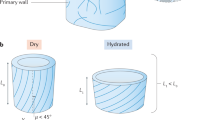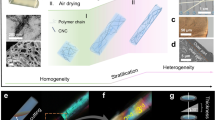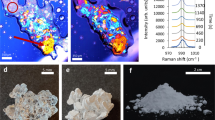Abstract
Hygroscopic biological matter in plants, fungi and bacteria make up a large fraction of Earth’s biomass1. Although metabolically inert, these water-responsive materials exchange water with the environment and actuate movement2,3,4,5 and have inspired technological uses6,7. Despite the variety in chemical composition, hygroscopic biological materials across multiple kingdoms of life exhibit similar mechanical behaviours including changes in size and stiffness with relative humidity8,9,10,11,12,13. Here we report atomic force microscopy measurements on the hygroscopic spores14,15 of a common soil bacterium and develop a theory that captures the observed equilibrium, non-equilibrium and water-responsive mechanical behaviours, finding that these are controlled by the hydration force16,17,18. Our theory based on the hydration force explains an extreme slowdown of water transport and successfully predicts a strong nonlinear elasticity and a transition in mechanical properties that differs from glassy and poroelastic behaviours. These results indicate that water not only endows biological matter with fluidity but also can—through the hydration force—control macroscopic properties and give rise to a ‘hydration solid’ with unusual properties. A large fraction of biological matter could belong to this distinct class of solid matter.
This is a preview of subscription content, access via your institution
Access options
Access Nature and 54 other Nature Portfolio journals
Get Nature+, our best-value online-access subscription
$29.99 / 30 days
cancel any time
Subscribe to this journal
Receive 51 print issues and online access
$199.00 per year
only $3.90 per issue
Buy this article
- Purchase on Springer Link
- Instant access to full article PDF
Prices may be subject to local taxes which are calculated during checkout





Similar content being viewed by others
Data availability
Source data for Figs. 1a,d–f, 3a,b, 4a–i and 5b,c, and Extend Data Figs. 2, 4 and 5 are included with the paper. The raw data for cantilever deflections (Fig. 1c–f), spore height (Figs. 1a and 3a,b), force–distance curves (Fig. 4b–f) and dynamic stiffness measurements (Fig. 5c) are available in figshare (https://doi.org/10.6084/m9.figshare.22189823)58.
Code availability
The MATLAB codes used for data processing, curve fitting, and plotting are available in figshare (https://doi.org/10.6084/m9.figshare.22189823)58.
Change history
14 June 2023
In the HTML version of this article initially published, Extended Data Figures 1–3 were interchanged and are now updated in the HTML version of the article. The PDF was unaffected.
References
Bar-On, Y. M., Phillips, R. & Milo, R. The biomass distribution on Earth. Proc. Natl Acad. Sci. USA 115, 6506–6511 (2018).
Dawson, C., Vincent, J. F. V. & Rocca, A.-M. How pine cones open. Nature 390, 668–668 (1997).
Elbaum, R., Zaltzman, L., Burgert, I. & Fratzl, P. The role of wheat awns in the seed dispersal unit. Science 316, 884–886 (2007).
Fratzl, P. & Barth, F. G. Biomaterial systems for mechanosensing and actuation. Nature 462, 442–448 (2009).
Dumais, J. & Forterre, Y. “Vegetable dynamicks”: the role of water in plant movements. Ann. Rev. Fluid Mech. 44, 453–478 (2012).
Burgert, I. & Fratzl, P. Actuation systems in plants as prototypes for bioinspired devices. Phil. Trans. R. Soc. A 367, 1541–1557 (2009).
Chen, X. et al. Scaling up nanoscale water-driven energy conversion into evaporation-driven engines and generators. Nat. Commun. 6, 7346 (2015).
Pasanen, A. L., Pasanen, P., Jantunen, M. J. & Kalliokoski, P. Significance of air humidity and air velocity for fungal spore release into the air. Atmos. Environ. Part A 25, 459–462 (1991).
Zhao, L., Schaefer, D. & Marten, M. R. Assessment of elasticity and topography of Aspergillus nidulans spores via atomic force microscopy. Appl. Environ. Microbiol. 71, 955–960 (2005).
Agnarsson, I., Dhinojwala, A., Sahni, V. & Blackledge, T. A. Spider silk as a novel high performance biomimetic muscle driven by humidity. J. Exp. Biol. 212, 1990–1994 (2009).
Sahin, O., Yong, E. H., Driks, A. & Mahadevan, L. Physical basis for the adaptive flexibility of Bacillus spore coats. J. R. Soc. Interface 9, 3156–3160 (2012).
Qu, Z. & Meredith, J. C. The atypically high modulus of pollen exine. J. R. Soc. Interface 15, 20180533 (2018).
Lazarus, B. S. et al. Engineering with keratin: a functional material and a source of bioinspiration. iScience 24, 102798 (2021).
Westphal, A. J., Price, P. B., Leighton, T. J. & Wheeler, K. E. Kinetics of size changes of individual Bacillus thuringiensis spores in response to changes in relative humidity. Proc. Natl Acad. Sci. USA 100, 3461 (2003).
Chen, X., Mahadevan, L., Driks, A. & Sahin, O. Bacillus spores as building blocks for stimuli-responsive materials and nanogenerators. Nat. Nanotechnol. 9, 137–141 (2014).
Israelachvili, J. N. & Pashley, R. M. Molecular layering of water at surfaces and origin of repulsive hydration forces. Nature 306, 249–250 (1983).
Rau, D. C. & Parsegian, V. A. Direct measurement of forces between linear polysaccharides xanthan and schizophyllan. Science 249, 1278–1281 (1990).
Parsegian, V. A. & Zemb, T. Hydration forces: observations, explanations, expectations, questions. Curr. Opin. Colloid Interface Sci. 16, 618–624 (2011).
Nicholson, W. L., Munakata, N., Horneck, G., Melosh, H. J. & Setlow, P. Resistance of Bacillus endospores to extreme terrestrial and extraterrestrial environments. Microbiol. Mol. Biol. Rev. 64, 548–572 (2000).
Gerhardt, P. & Black, S. H. Permeability of bacterial spores II. J. Bacteriol. 82, 750–760 (1961).
Mertens, J. et al. Label-free detection of DNA hybridization based on hydration-induced tension in nucleic acid films. Nat. Nanotechnol. 3, 301–307 (2008).
Moeendarbary, E. et al. The cytoplasm of living cells behaves as a poroelastic material. Nat. Mater. 12, 253–261 (2013).
Krynicki, K., Green, C. D. & Sawyer, D. W. Pressure and temperature dependence of self-diffusion in water. Faraday Discuss. Chem. Soc. 66, 199–208 (1978).
Biot, M. A. General theory of three‐dimensional consolidation. J. Appl. Phys. 12, 155–164 (1941).
Storm, C., Pastore, J. J., MacKintosh, F. C., Lubensky, T. C. & Janmey, P. A. Nonlinear elasticity in biological gels. Nature 435, 191–194 (2005).
Sheiko, S. S. & Dobrynin, A. V. Architectural code for rubber elasticity: from supersoft to superfirm materials. Macromolecules 52, 7531–7546 (2019).
Granick, S., Bae, S. C., Kumar, S. & Yu, C. Confined liquid controversies near closure? Physics 3, 73 (2010).
Khan, S. H., Matei, G., Patil, S. & Hoffmann, P. M. Dynamic solidification in nanoconfined water films. Phys. Rev. Lett. 105, 106101 (2010).
Liu, A. J. & Nagel, S. R. The jamming transition and the marginally jammed solid. Annu. Rev. Condens. Matter Phys. 1, 347–369 (2010).
Hu, Y., Zhao, X., Vlassak, J. J. & Suo, Z. Using indentation to characterize the poroelasticity of gels. Appl. Phys. Lett. 96, 121904 (2010).
Wheeler, T. D. & Stroock, A. D. The transpiration of water at negative pressures in a synthetic tree. Nature 455, 208–212 (2008).
Bertinetti, L., Fratzl, P. & Zemb, T. Chemical, colloidal and mechanical contributions to the state of water in wood cell walls. New J. Phys. 18, 083048 (2016).
Garcia, R. Nanomechanical mapping of soft materials with the atomic force microscope: methods, theory and applications. Chem. Soc. Rev. 49, 5850–5884 (2020).
Kulasinski, K., Derome, D. & Carmeliet, J. Impact of hydration on the micromechanical properties of the polymer composite structure of wood investigated with atomistic simulations. J. Mech. Phys. Solids 103, 221–235 (2017).
Fernandes, A. N. et al. Nanostructure of cellulose microfibrils in spruce wood. Proc. Natl Acad. Sci. USA 108, E1195–E1203 (2011).
Yasuda, H. et al. Mechanical computing. Nature 598, 39–48 (2021).
Hong, W., Zhao, X., Zhou, J. & Suo, Z. A theory of coupled diffusion and large deformation in polymeric gels. J. Mech. Phys. Solids 56, 1779–1793 (2008).
Harwood, C. R. & Cutting, S. M. Molecular Biological Methods For Bacillus (Wiley, 1990).
Scherrer, R., Beaman, T. C. & Gerhardt, P. Macromolecular sieving by the dormant spore of Bacillus cereus. J. Bacteriol. 108, 868–873 (1971).
Rubinson, K. A. & Krueger, S. Poly(ethylene glycol)s 2000–8000 in water may be planar: a small-angle neutron scattering (SANS) structure study. Polymer 50, 4852–4858 (2009).
Dünweg, B., Reith, D., Steinhauser, M. & Kremer, K. Corrections to scaling in the hydrodynamic properties of dilute polymer solutions. J. Chem. Phys. 117, 914–924 (2002).
Carrera, M., Zandomeni, R. O. & Sagripanti, J.-L. Wet and dry density of Bacillus anthracis and other Bacillus species. J. Appl. Microbiol. 105, 68–77 (2008).
Fischer, H., Polikarpov, I. & Craievich, A. F. Average protein density is a molecular-weight-dependent function. Protein Sci. 13, 2825–2828 (2004).
Knudsen, S. M. et al. Water and small-molecule permeation of dormant Bacillus subtilis spores. J. Bacteriol. 198, 168–177 (2016).
Ghosh, S. et al. Characterization of spores of Bacillus subtilis that lack most coat layers. J. Bacteriol. 190, 6741–6748 (2008).
Nagler, K. et al. Involvement of coat proteins in Bacillus subtilis spore germination in high-salinity environments. Appl. Environ. Microbiol. 81, 6725–6735 (2015).
Wells-Bennik, M. H. J. et al. Bacterial spores in food: survival, emergence, and outgrowth. Annu. Rev. Food Sci. Technol. 7, 457–482 (2016).
Driks, A., Roels, S., Beall, B., Moran, C. P. & Losick, R. Subcellular localization of proteins involved in the assembly of the spore coat of Bacillus subtilis. Genes Dev. 8, 234–244 (1994).
McKenney, P. T., Driks, A. & Eichenberger, P. The Bacillus subtilis endospore: assembly and functions of the multilayered coat. Nat. Rev. Microbiol. 11, 33–44 (2013).
Yoon, J., Cai, S., Suo, Z. & Hayward, R. C. Poroelastic swelling kinetics of thin hydrogel layers: comparison of theory and experiment. Soft Matter 6, 6004–6012 (2010).
Raviv, U., Laurat, P. & Klein, J. Fluidity of water confined to subnanometre films. Nature 413, 51–54 (2001).
Patil, S., Matei, G., Oral, A. & Hoffmann, P. M. Solid or liquid? solidification of a nanoconfined liquid under nonequilibrium conditions. Langmuir 22, 6485–6488 (2006).
Pearce, S. P. et al. Finite indentation of highly curved elastic shells. Proc. R. Soc. A 474, 20170482 (2018).
Popov, V. L., Heß, M. & Willert, E. Handbook of Contact Mechanics: Exact Solutions of Axisymmetric Contact Problems (Springer Nature, 2019).
Puttock, M. & Thwaite, E. Elastic Compression of Spheres and Cylinders at Point and Line Contact (Commonwealth Scientific and Industrial Research Organization, 1969).
Garcia, P. D. & Garcia, R. Determination of the elastic moduli of a single cell cultured on a rigid support by force microscopy. Biophys. J. 114, 2923–2932 (2018).
Fletcher, N. H. In The Chemical Physics of Ice 165–197 (Cambridge Univ. Press, 1970).
Harrellson, S. G. et al. Data for hydration solids. figshare https://doi.org/10.6084/m9.figshare.22189823 (2023).
Plomp, M., Leighton, T. J., Wheeler, K. E. & Malkin, A. J. The high-resolution architecture and structural dynamics of Bacillus spores. Biophys. J. 88, 603–608 (2005).
Pasquina-Lemonche, L. et al. The architecture of the Gram-positive bacterial cell wall. Nature 582, 294–297 (2020).
Setlow, P. Spores of Bacillus subtilis: their resistance to and killing by radiation, heat and chemicals. J. Appl. Microbiol. 101, 514–525 (2006).
Dittmann, C., Han, H.-M., Grabenbauer, M. & Laue, M. Dormant Bacillus spores protect their DNA in crystalline nucleoids against environmental stress. J. Struct. Biol. 191, 156–164 (2015).
Lee, S. A. et al. A Brillouin scattering study of the hydration of Li- and Na-DNA films. Biopolymers 26, 1637–1665 (1987).
Cowan, A. E., Koppel, D. E., Setlow, B. & Setlow, P. A soluble protein is immobile in dormant spores of Bacillus subtilis but is mobile in germinated spores: implications for spore dormancy. Proc. Natl Acad. Sci. USA 100, 4209–4214 (2003).
Sunde, E. P., Setlow, P., Hederstedt, L. & Halle, B. The physical state of water in bacterial spores. Proc. Natl Acad. Sci. USA 106, 19334–19339 (2009).
Acknowledgements
We acknowledge A. Driks (Department of Microbiology and Immunology, Loyola University Chicago, Maywood, IL, USA) who passed away before the completion of the work for contributing spores, and for discussions that informed the hygroelastic theory and for suggesting the use of known sieving properties of spores as an estimate of pore size. Funding was provided by US Department of Energy (DOE) Early Career Research Program, Office of Science, Basic Energy Sciences (BES), under award no. DE-SC0007999 (Fig. 1 and experimental data in Figs. 3 and 4); by the Office of Naval Research, under award nos. N00014-19-1-2200 (Fig. 5 and theoretical analyses in Figs. 3 and 4) and N00014-21-1-4004 (theoretical analyses in Figs. 3 and 4); by the National Institute of General Medical Sciences of the National Institutes of Health, under award nos. R35GM141953 (to J.D.) and R35GM145382 (to O.S.); and by the David and Lucile Packard Fellows Program. We acknowledge the use of facilities and instrumentation supported by NSF through the Columbia University, Columbia Nano Initiative, and the Materials Research Science and Engineering Center DMR-2011738.
Author information
Authors and Affiliations
Contributions
M.D., X.C. and O.S. designed the experiments probing relaxation kinetics with nanomechanical cantilever sensors. M.D. and X.C. developed the experimental apparatus for relaxation kinetics measurements. M.D. conducted the relaxation kinetics measurements. M.D., S.G.H, A.-H.C. and O.S. contributed to the analysis of relaxation kinetics measurements. M.D. and S.G.H. conducted spore height measurements. X.C. conducted force–distance curve measurements. S.G.H. and O.S. analysed measurements of water-responsive size change and nonlinear elasticity of spores. S.G.H. and O.S. designed experiments probing the hygroelastic transition. S.G.H. conducted the experiments probing the hygroelastic transition and analysed the data. H.A.S. contributed to the theoretical analysis of the hygroelastic transition. J.D. contributed materials. O.S. conceived the hygroelastic model. S.G.H. aided in the development and refinement of the hygroelastic model. M.D., S.G.H., J.D., H.A.S. and O.S. contributed to the discussions. O.S. designed the research. M.D., S.G.H. and O.S. prepared the paper with input from all authors.
Corresponding author
Ethics declarations
Competing interests
The authors declare no competing interests.
Peer review
Peer review information
Nature thanks Peter Hoffmann and the other, anonymous, reviewer(s) for their contribution to the peer review of this work. Peer reviewer reports are available.
Additional information
Publisher’s note Springer Nature remains neutral with regard to jurisdictional claims in published maps and institutional affiliations.
Extended data figures and tables
Extended Data Fig. 1 Spore-coated cantilever.
Scanning electron microscopy image of a spore-coated cantilever. Scale bar ~20 µm. The cantilever is T-shaped, and it is approximately 300 µm long and 30 µm wide, except near the free end where the width is approximately 60 µm.
Extended Data Fig. 2 Cantilever deflection signals.
Representative cantilever deflection signals following photothermal pulses shown for a range of relative humidity levels. Deflection signals are normalized so that peak-to-peak deflection corresponds to 1. All curves are obtained with the same spore-coated cantilever. They are representative of curves from all five cantilevers used in Fig. 1d.
Extended Data Fig. 3 Microstructure and properties of spores.
a, Scanning electron microscopy image of the spores of B. subtilis. Scale bar: 500 nm. Wild type spores of B. subtilis are approximately 650 nm in diameter and 1 um to 1.5 um in length. b, Illustration of the cross section of spores of B. subtilis showing the cortex and coat layers that surround the core, which contains the genetic material. The coat is a proteinaceous, water-permeable layer49. AFM images of the outer surface of the coat reveals an assembly of parallel rodlets formed by coat proteins with ~ 8 nm periodicity59. The cortex, also a water permeable layer, is a loosely crosslinked network of peptidoglycan that is similar in structure to that of vegetative cells. The vegetative peptidoglycan in B. subtilis has an average diameter of 4 nm, as observed in AFM images60. The thicknesses of the coat and the cortex layers are approximately 70 nm each (see Methods). The spore core contains proteins and DNA. The core is dehydrated61 and the DNA is packed in a crystalline state62. Elastic modulus measurements of DNA films in crystalline state show the Young’s modulus of these films to be approximately 1.1 GPa63, suggesting that the core is a stiff solid rather than a fluid. This assumption is also supported by the observation that soluble biomolecules are immobile in the dehydrated cores of dormant spores but gain mobility upon germination when the core gets hydrated64. The spore water, however, exhibits rotational mobility, as indicated by the observations of short rotational correlation times of D2O in spores65. This observation also indicates that water in spores is not in an ice-like (solid) state.
Extended Data Fig. 4 Relative effect of the photothermal pulse.
Shifts in the resonance frequency of spore-coated cantilevers are sensitive to the amount of water exchange. We used this effect to compare relative effects of the photothermal pulse and RH. Here we plot the relative changes in fundamental resonance frequency of a cantilever coated with spores in two cases: (left, red bar) as a result of photothermal pulse and (right, purple bar) in response to a change in relative humidity from 80% to 10%. The results are given as percentages. They indicate that the perturbation due to the photothermal pulse is small, and therefore, the transient deflections of the cantilever in response to photothermal pulses reflect approximately the state of the spore at the set-point level of the relative humidity.
Extended Data Fig. 5 Time constants and the total spore mass.
The spore quantities are represented by spore mass estimated from the shifts in cantilever resonance frequencies. Time constants are plotted for wild type B. subtilis (square) and B. subtilis cotE gerE (circle) spores. According to the data, there is a lack of clear association between the time constant and the total spore mass, however the effect of spore type results in a statistically significant change in time constants: Mean time constant at 50% RH for wild type B. subtilis [square] is ~118 ms and ~47.1 ms for B. subtilis cotE gerE [circle] (one-tailed T, p < .01).
Supplementary information
Rights and permissions
Springer Nature or its licensor (e.g. a society or other partner) holds exclusive rights to this article under a publishing agreement with the author(s) or other rightsholder(s); author self-archiving of the accepted manuscript version of this article is solely governed by the terms of such publishing agreement and applicable law.
About this article
Cite this article
Harrellson, S.G., DeLay, M.S., Chen, X. et al. Hydration solids. Nature 619, 500–505 (2023). https://doi.org/10.1038/s41586-023-06144-y
Received:
Accepted:
Published:
Issue Date:
DOI: https://doi.org/10.1038/s41586-023-06144-y
This article is cited by
-
High-energy density cellulose nanofibre supercapacitors enabled by pseudo-solid water molecules
Scientific Reports (2024)
Comments
By submitting a comment you agree to abide by our Terms and Community Guidelines. If you find something abusive or that does not comply with our terms or guidelines please flag it as inappropriate.



